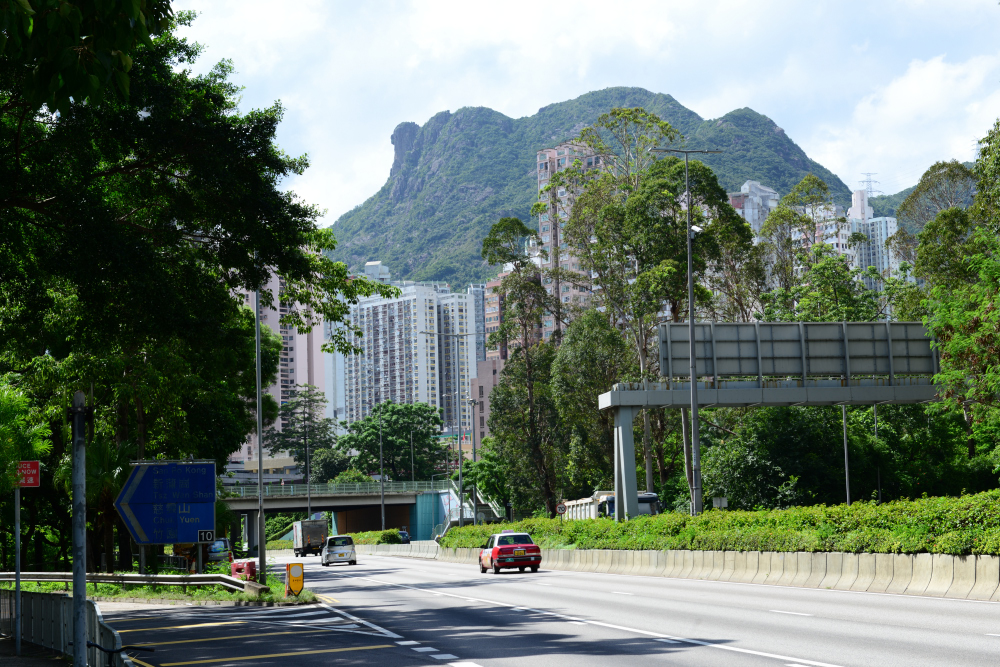URBAN HILLS OF HONG KONG: LION ROCK (獅子山), Wong Tai Sin (黃大仙), Kowloon, Hong Kong

At the lookout of Ping Shan, the distant Lion Rock stands as the most recognizable feature in the scenery of Kowloon. In Hong Kong, there is no other peaks like the Lion Rock. Reaching a height of 495m, the iconic hill has been the symbol of “Hong Kong spirit” since the 1970’s. In 1972, a TV show named Below the Lion Rock (獅子山下) was broadcasted on RTHK, the official public broadcasting channel in the city. The show presents stories of the grass-root community, many of whom were Chinese refugees living in neighborhoods below Lion Rock, reestablishing their lives in Hong Kong after WWII and the Chinese Civil War. The show also covers stories of Hongkongers in context of various social issues. It was produced and broadcasted on and off from 1972 till the present. In 1979, a theme song for the show with the same name came out. Dealing with the collective spirit of persistence and pursuit of dreams during hardships, the song soon became the unofficial anthem for not just the communities below Lion Rock, but also the entire city. Prominently situated over Central Kowloon, Lion Rock has become the city’s cultural symbol during the formative years, when Hong Kong was rapidly reinventing itself from an industrial hub to an international financial centre. Today, Lion Rock still reminds people to the city’s humble years, and the collective fighting spirit of its people.
Putting aside its symbolic meanings, with its shape that resembles a crouching lion, the Lion Rock is also physically one of the most recognizable peaks in Hong Kong. The hill is visible from many districts in the city, even across Victoria Harbour. Its peak is also accessible from various neighborhoods, such as Wong Tai Sin (黃大仙), Tsz Wan Shan (慈雲山), and Tai Wai (大圍). No matter which trailhead to start from, the hike up the summit would usually take less than 2 hours. For us, it was always a spontaneous decision to hike up. We managed to summit Lion Rock three times, but not a single time did we enjoy the view from the top in a smog free day. Due to the popularity of Lion Rock, it was always crowded on the top, especially on the rocky summit where everyone is searching for the best selfie spot. Despite the smog, views of the evening skyline still captivated us each time when we stood up there. Someday, we will hike up Lion Rock again on a perfect day.
















URBAN HILLS OF HONG KONG: PING SHAN (平山), Kowloon Bay (九龍灣), Kowloon, Hong Kong

Hong Kong is a hilly city. As a city where everything are placed so compactly together, many urban neighborhoods in Hong Kong are located in close proximity to natural hills. Land shortage has not only forced the city to reclaim land from the sea, but also to remold its hilly terrain for all kinds of purposes. Throughout the years, some hills have been completely wiped out while some have gone through heavy transformations. For the hills that remain standing today, many have become an integral part of the city, especially the ones closest to urban centres. Aesthetically, their prominent presence have become iconic backdrops for the city’s skyline. Functionally, some have seen their cliffs carved out for stone quarries, summits hollowed out for communal cisterns, or slopes flattened for terracing parks. Socially, their convenient location to the surrounding neighborhoods have formed a sense of place for local residents as if their communal backyard. Culturally, their eternal existence have inspired stories, music and artworks, forming a crucial part of the collective psyche for all Hongkongers. Today, many of these “urban hills” have even become popular destinations for short hikes and urban photography. During the pandemic, we have visited a number of them for their unique urban heritage and splendid vistas of the city. We would pick some to share on this blog.
In Kowloon East, between Kowloon Bay (九龍灣) and Kowloon Peak (飛鵝山) stands Ping Shan (平山), a relatively unknown hill that has been greatly diminished after decades of stone quarrying. The last quarry at Ping shan was shut down in 1974 to make way for MTR (metro) and public housing constructions. Today, as part of the lush green Jordan Valley Park, Ping Shan has become an unofficial backyard for residents from the nearby public housing estates. Thanks to social media, Ping Shan has gained significant popularity as a destination to watch sunset over the silhouette of the iconic Lion Rock (獅子山). From Kowloon Bay MTR Station, the walk to the trailhead takes about 20 minutes, from which another 10 minutes of stair climbing to reach the lookout. We have been there twice. On both occasions, we enjoyed watching the sun slowly retreating below the city’s skyline, while the sky gradually turned from orange to violet to charcoal blue.


















